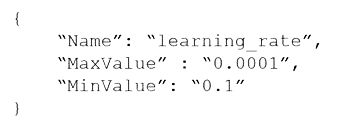Sharpen Your Knowledge with Amazon (MLS-C01) Certification Sample Questions
CertsTime has provided you with a sample question set to elevate your knowledge about the Amazon AWS Certified Machine Learning - Specialty exam. With these updated sample questions, you can become quite familiar with the difficulty level and format of the real MLS-C01 certification test. Try our sample Amazon AWS Certified Machine Learning - Specialty certification practice exam to get a feel for the real exam environment. Our sample practice exam gives you a sense of reality and an idea of the questions on the actual Amazon Specialty certification exam.
Our sample questions are similar to the Real Amazon AWS ML Specialty MLS-C01 exam questions. The premium Amazon AWS Certified Machine Learning - Specialty certification practice exam gives you a golden opportunity to evaluate and strengthen your preparation with real-time scenario-based questions. Plus, by practicing real-time scenario-based questions, you will run into a variety of challenges that will push you to enhance your knowledge and skills.
Amazon MLS-C01 Sample Questions:
A real-estate company is launching a new product that predicts the prices of new houses. The historical data for the properties and prices is stored in .csv format in an Amazon S3 bucket. The data has a header, some categorical fields, and some missing values. The company's data scientists have used Python with a common open-source library to fill the missing values with zeros. The data scientists have dropped all of the categorical fields and have trained a model by using the open-source linear regression algorithm with the default parameters.
The accuracy of the predictions with the current model is below 50%. The company wants to improve the model performance and launch the new product as soon as possible.
Which solution will meet these requirements with the LEAST operational overhead?
A manufacturing company wants to use machine learning (ML) to automate quality control in its facilities. The facilities are in remote locations and have limited internet connectivity. The company has 20 of training data that consists of labeled images of defective product parts. The training data is in the corporate on-premises data center.
The company will use this data to train a model for real-time defect detection in new parts as the parts move on a conveyor belt in the facilities. The company needs a solution that minimizes costs for compute infrastructure and that maximizes the scalability of resources for training. The solution also must facilitate the company's use of an ML model in the low-connectivity environments.
Which solution will meet these requirements?
A machine learning (ML) specialist is using Amazon SageMaker hyperparameter optimization (HPO) to improve a model's accuracy. The learning rate parameter is specified in the following HPO configuration:

During the results analysis, the ML specialist determines that most of the training jobs had a learning rate between 0.01 and 0.1. The best result had a learning rate of less than 0.01. Training jobs need to run regularly over a changing dataset. The ML specialist needs to find a tuning mechanism that uses different learning rates more evenly from the provided range between MinValue and MaxValue.
Which solution provides the MOST accurate result?
A retail company wants to update its customer support system. The company wants to implement automatic routing of customer claims to different queues to prioritize the claims by category.
Currently, an operator manually performs the category assignment and routing. After the operator classifies and routes the claim, the company stores the claim's record in a central database. The claim's record includes the claim's category.
The company has no data science team or experience in the field of machine learning (ML). The company's small development team needs a solution that requires no ML expertise.
Which solution meets these requirements?
A machine learning (ML) specialist needs to extract embedding vectors from a text series. The goal is to provide a ready-to-ingest feature space for a data scientist to develop downstream ML predictive models. The text consists of curated sentences in English. Many sentences use similar words but in different contexts. There are questions and answers among the sentences, and the embedding space must differentiate between them.
Which options can produce the required embedding vectors that capture word context and sequential QA information? (Choose two.)
Note: If there is any error in our Amazon MLS-C01 certification exam sample questions, please update us via email at support@certstime.com.



 Try Before You Buy!
Try Before You Buy!